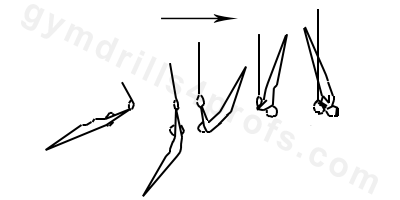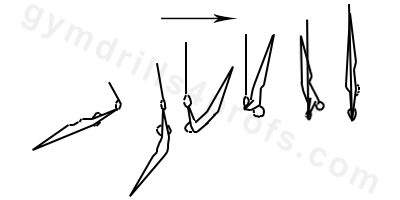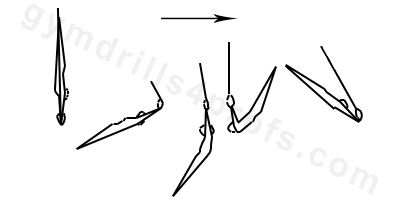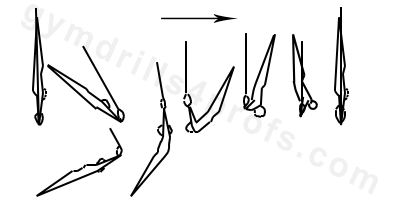


The back giant on rings begins from a properly executed handstand. The bail should begin with the gymnast pushing the rings forward. The gymnast should maintain tension on the rings to reduce slack on the cables, and so that the swing can reach its maximum potential. The body should remain straight throughout the bail, until the gymnast is directly under the rings. At this point, the gymnast should keep a tight arch through the bottom of the swing while maintaining pressure on the rings. The gymnast should then kick their heels upward in a candlestick position as they begin the next part of the back giant. The body should turnover into an inverted vertical position, and the gymnast should put backward pressure on the rings. This will help the body rise into the handstand. The gymnast can push the rings outward to help put more pressure on the rings. The gymnast should finish the back giant in a controlled handstand.

At the highest point in the back swing, the shoulders should be extended with the rings going slightly sideways. The body should be in an arched position. From the top of the swing, continuous shoulder extension toward the bottom of the swing must be maintained. This helps the gymnast maintain the arched body position until the bottom of the swing. At the bottom, the gymnast should kick the legs forward and upward to make their entire body turn over as fast as possible. The gymnast should attempt to kick from their upper chest at the bottom. Shoulder should remain extended and stay down until the entire body turns over completely. The rings should be pushed backward when the gymnast’s feet are pointed towards the ceiling. The rings should turn parallel (wrists facing one another). The rings should not go sideways during this portion of the swing. The final position is a higher point of the front swing, where the body should be in a slight hollow position with arms tight and parallel. The head should be neutral with the gymnast maintaining backward pressure on the rings. From the highest point of the front swing starts the backswing. The body should swing down in a hollow position without losing pressure on the rings. At the bottom, the gymnast should initiate a strong kick off their heels. During the turnover phase, the head should stay down to facilitate a stronger heel lift. Shoulders should remain low. When their heels have risen and their toes are directed upward toward the ceiling, the rings can be slightly open, the head will be slightly elevated as well. The final position of the backswing is arched. VERY IMPORTANT: In the backswing, do not pull down on the rings. The leading motion of the move is the kick back with the heels.

The dislocate skill is an excellent exercise to practice giant swings. Ideally, a disclocate is done with enough height and pressure on the rings so that the gymnast is able to pass through handstand above the rings. There are a few variations and progressions of the dislocate skill. The first (and easiest) is the piked dislocate, followed by the stretched dislocate and eventually giant swing. Regardless of the variation, the body should stay hollow throughout the majority of the skill until reaching the vertical position. Once the gymnast reaches this position, they should straighten their body shape slightly but avoid significant arching. The gymnast’s head should remain neutral or down in order to avoid arching from the upper back and to help maintain more pressure on the rings as they pass through vertical. As the gymnast finishes the shifting from their shoulders, they should push the rings forward and lead from their chest as they reach the bottom of the swing. At this point, they can begin to arch through the bottom of the swing in order to kick their legs and hips for acceleration. The athlete should be very familiar with maintaining a candlestick body shape and keeping pressure on the rings. A common mistake that many gymnasts make when attempting the dislocate for the first time is arching their body as they pass through vertical. This can lead to a lack of control, height, and pressure on the rings. This can be a difficult habit to break and for this reason, it’s important to emphasize the proper technique when first learning the skill. Spotting and holding the gymnast as they pass through vertical can be an effective method in teaching them the correct body positions.

The handstand is a very common skill. It can be static (held), or dynamic, where the gymnast passes through the handstand briefly. A handstand on rings is typically more difficult than other variations. This is because the rings themselves are not static, which means that the gymnast needs to have basic strength requirements in order to balance properly. The arms should be parallel at the width of the shoulders. Also, they shouldn’t touch the cables. The arms and legs should be completely straight. The shoulder angle should be completely extended. During the handstand, the butt and core should be tight, and the head should be in a neutral position with the eyes watching the hands. It’s very important not to watch the hands with the head back, as this can lead to arching through the entire back. The wrists are turned out, which allow the rings to be parallel and even overturned.

The drill should be done with straps. It gives the gymnast confidence to relax and unleash the swing. The athlete should do several dislocates and gradually raise them until the last one reaches the handstand. In the execution of the dislocates, the arms should close as much as possible. The rule is that as the dislocates increase in height, the arms should go closer and closer together.

From a swing or from a dislocate, the gymnast finishes the move in shoulderstand. The body should be in a hollow position in the front swing until shoulderstand.

The gymnast performs 2-3 dislocates and during the last one, they should bend their arms and reach handstand. Bending the arms helps the gymnast reach handstand easier. This is a good drill to practice the back giant with, but the bent arms should gradually be eliminated because it’s not the proper technique. Despite the bent arms, the gymnast should still follow the general rules of the back giant. They should be hollow during the entire execution of the high dislocates, and gradually close the rings closer and closer. In the beginning, the exercise can be performed with a spotter.

The first part of the back giant is the bail to hang. This drill emphasizes exactly on this move. From handstand, the gymnast bails with an extended body and parallel tight arms. The circle should be as long as possible. During the hang, the gymnast performs a tap with a tight arch and continues with dislocates.

The next step is to connect the previous two sequences. The athlete emphasizes the position of the body and the arms, and the long bail to hang position.

The last step of the progression is to perform the back giant with tight arms. The gymnast can use the cables for assistance as they reach handstand.
Integral part of gymnastics coaching process are skill drills. They help gymnasts to learn easier and technically correct. With GYM DRILL PRO you will find variety of ideas for the most the basic gymnastics skills. There are plenty of images with skill drill progressions. It is intended to support explicitly the qualified coaches in their daily coaching business. DO NOT practice without the guidance of proper professionals.